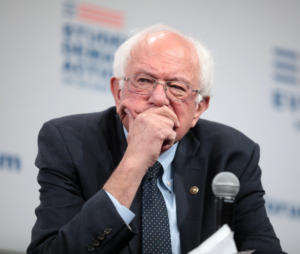Promulgating the steady state economy via federal legislation has long been a primary goal at CASSE. However, even a primary goal isn’t necessarily pursued from the get-go. Much of the CASSE run thus far has been focused on raising awareness of the need for a steady state economy. Raising such awareness was even higher on the list of goals, because drafting statutory law is of limited use if there is no knowledge of the need for it.
In the midst of the Covid crisis, fifteen years after the establishment of CASSE, we formally commenced developing a steady state economy bill. Covid forced the societal door open for some rethinking of economic policies and activities. We walked through the door and introduced the steady state economy as a post-covid policy vision.
The tentative title of the bill was the “Full and Sustainable Employment Act” (FSEA). We chose this title to emphasize the wholesale replacement of the Full Employment and Balanced Growth Act of 1978 (FEBGA). If the United States has a central economic policy, it’s FEBGA, a pro-growth law hopelessly out of date. (As we like to say at CASSE, growth is sooo 20th century.)
We went so far as to nickname our own developmental bill the “Full Seas Act.” The idea (as elaborated in Supply Shock) was to put an end to the excuse-making metaphor, “a rising tide lifts all boats.” In the 21st century, we’ve run out of material for building more “boats.” We’re running out of room “at sea,” too. A sustainable economy means replacing the boats as they run their life course, not trying to force even more boats—people, businesses, industries—onto the crowded seas.
Our testing of the metaphorical waters was inconclusive, and in 2023 we simply renamed the bill the “Steady State Economy Act.” Putting the phrase “steady state economy” in the very title of the bill makes it crystal clear that we are literally proposing the establishment of a steady state economy in the USA, and not just whistling Dixie.
Findings and Declarations
Perhaps the most important section of a statute is the findings and declarations of Congress. In most substantial laws, the findings and declarations set the stage for the rest of the content. Take, for example, the Endangered Species Act of 1973, in which Congress found and declared that species “have been rendered extinct as a consequence of economic growth and development.” This crucial phrase will forever serve as a reminder that Congress set the precedent long ago in recognizing the ecological threat of economic growth.
For the Steady State Economy Act (SSEA), we had the advantage of having our key findings and declarations—the ones we want Congress to adopt—thought out far in advance. The findings, especially, have taken the form of an online, signable position statement for two decades. Similarly, the declarations stem from the “therefore” clauses of the position statement.
The findings and declarations in the SSEA were first presented under the “Full Seas Act” noted above. Providing them here will reinforce these central pillars of the SSEA, where they will comprise Section 2:
SECTION 2. FINDINGS AND DECLARATIONS.
(a) FINDINGS. The Congress finds that—
(1) Economic growth, as measured with gross domestic product (GDP), requires a growing human population, increasing per capita consumption, or both.
(2) Consistent with the natural sciences, including basic principles of physics and biology, there are limits to economic growth within and among nations.
(3) There is a fundamental conflict between economic growth and environmental protection, including the maintenance of: clean air and water; productive soils; biological diversity; stocks of natural resources including water, timber, fisheries, minerals, and fossil fuels, and; funds of ecosystem services including nutrient cycling, pollination, waste absorption, and carbon sequestration.
(4) A well-maintained, non-degraded environment is the foundation of a productive economy. Therefore, and because of the fundamental conflict between economic growth and environmental protection, there is also a fundamental conflict between economic growth and the long-term maintenance of the economy including jobs, income, and wellbeing.
(5) A well-maintained economy is vital to national defense. Therefore, and because of the fundamental conflict between economic growth and the long-term maintenance of the economy, there is a fundamental conflict between economic growth and national security.
(6) There is abundant environmental and economic evidence that long-term limits to growth have been and are being reached and exceeded in the Nation, other nations, and globally.
(7) There is abundant evidence that perennial fiscal and monetary efforts to stimulate GDP growth are increasingly causing environmental, economic, and social harm while resulting in fewer benefits, with the harm gradually exceeding the benefits.
(b) DECLARATION. The Congress declares that—
(1) It is heretofore the policy of the Nation to undertake a gradual but certain transition from the goal and pursuit of economic growth to the goal and pursuit of a sustainable steady state economy, with stabilized or mildly fluctuating population and per capita consumption as generally indicated, all else being equal, by a mildly fluctuating GDP.
(2) The transition to a steady state economy must be undertaken with every intent and effort to achieve and maintain the full employment of the labor force consistent with environmental protection and other aspects of economic sustainability including a balanced federal budget and the effective control of inflation.
(3) The President, President’s Cabinet, Council of Economic Advisors, Federal Reserve, and federal agency directors will immediately cease and desist from developing strategies and initiatives to grow or stimulate the economy. Existing policies, programs, and projects designed explicitly to grow or stimulate the economy shall not be extended beyond fiscal year 2030 or beyond the designated sunset date, whichever comes later.
(4) The Congressional Research Service, collaborating with the Office of Management and Budget and Council of Economic Advisers, will review and summarize the federal agency mission statements, goals, objectives, policies, programs, and practices designed for GDP growth, producing a Report on Federal Growth Incentives no later than 30 April 2031.
(5) A Commission on Economic Sustainability (“the Commission”) is hereby established to include the Administrator of the Environmental Protection Agency and the Secretaries of Agriculture, Energy, and Commerce, chaired by the Secretary of the Interior, to estimate and monitor environmentally sustainable levels of population and socially optimal levels of GDP. The Commission will produce a Report on Sustainable Population and Optimal GDP no later than 31 August 2031.
(6) The Commission Chair, with counsel of the Chairman of the Council of Economic Advisors, Secretary of Commerce, Federal Reserve Chair, and Secretary of the Treasury, drawing on the Report on Federal Growth Incentives and the Report on Sustainable Population and Optimal GDP, and pursuant to the framework provided in subsequent sections herein, will develop and deliver to the President, no later than 31 August 2032, a 25-year Steady-State Transition Plan detailing and scheduling the adjustments, modifications, additions, and deletions necessary to establish a system of government operations most conducive to a steady state economy at an estimated optimal level of GDP.
(7) The President, Cabinet secretaries, and federal agency directors shall not overlook the existence, neglect the enforcement, or underfund the performance of the Clean Air Act, Clean Water Act, Endangered Species Act, National Environmental Policy Act, or any other of the Nation’s environmental laws or regulations on grounds that said laws or regulations may interfere with the workings of the economy or slow the rate of GDP growth.
Progress on the Bill, Procedural and Strategic

Senator Bernie Sanders, concerned about excessive CEO pay, might like to ponder the Salary Cap Act. (Flickr)
The declarations above are more thorough than in a typical bill, as they are designed to put some procedural meat on the policy bone right from the start. As we develop the bill, some of the particulars laid out in the declarations will be shifted to subsequent sections.
Each significant section we draft is a prospective “feeder bill,” feeding into the broader SSEA. In this way, we hope to establish ties with members of Congress and their staff, as some of these feeder bills will be highly relevant to pre-existing concerns expressed on the Hill. For example, a recurring theme in Congress is the exorbitant pay of billionaire CEOs. Our Salary Cap Act ought to resonate with every politician who expresses a sincere concern about excessive income.
The Salary Cap Act is a good example of a bill that can unify those concerned especially with sustainability (thus far a small group including CASSE) and those concerned primarily with economic fairness (a larger number of individuals and organizations). Any feeder bill that connects with pre-existing concerns of members of Congress will help us educate those same members on limits to growth as well, and the need for a steady state economy. That helps us hew to our 501(c)(3) status as an educational non-profit organization with only limited lobbying clearance.
Below is the draft SSEA table of contents, provided only to the Section level. A more complete outline of the bill includes subsidiary sections, along with hyperlinks to a handful of feeder bills we’ve drafted thus far.
Section 1. Short Title; Table of Contents.
Section 2. Findings and Declarations.
Section 3. Definitions.
Section 4. Executive Adoption of Steady-State Goals.
Section 5. Fiscal Policy.
Section 6. Monetary Policy.
Section 7. Sustainable Immigration.
Section 8. Trade and Capital Mobility.
Section 9. Labor and Income.
Section 10. Housing and Transportation.
Section 11. Caps And Tradeable Permits.
Section 12. Economic Incentives.
Section 13. Prohibitions.
Section 14. Penalties and Enforcement.
This feeder bill approach won’t be without its challenges. Developing a complete collection of feeder bills doesn’t mean we will be able to simply splice them together to produce the SSEA. Rather, we’ll need to consolidate various components and pay careful attention to problems of redundancy or inconsistency. For example, most of our feeder bills will include a Definitions section. Those will be removed from their immediate context and compiled into a comprehensive Definitions section for the full SSEA. This type of work will require impeccable attention to detail, similar to the work performed by the Office of the Law Revision Counsel, the codifiers of statutory law. We are prepared to do this type of work in-house, slowly but surely.
As a small non-profit organization, we don’t have the resources to hire attorneys with copious legislative experience. However, we do have one full-time staffer devoted to the SSEA: Policy Specialist Daniel Wortel-London, who we hired in May, 2023. He has a Ph.D. from New York University and a keen interest in economic policy. Since signing on with CASSE, he has studied the canons of statutory construction and elements of style in drafting legislation. He assists with the development of feeder bills and monthly columns at the Steady State Herald, which are reviewed and fleshed out in-house.
As we develop more of the SSEA, we’ll be welcoming the help of individuals and organizations with an interest in the act as a whole or in particular feeder bills. A glance at the table of contents above, or further inspection of the deeper outline, should help third parties decide if they are interested in assessing, helping with, or funding the work. Potential collaborators should also consider some of the core policy principles we adhere to.
Policy Design Principles, Old and New
Each of our SSEA feeder bills follows the basic “SATG” model of public policy developed by political scientists Anne Schneider and Helen Ingram. The bill we draft is the statement (S) of policy, in which we identify the agent or agencies (A) charged with administering the policy. These agencies monitor and oversee actions by a particular “target” or targets (T) in order to fulfill the goal or goals (G) of the policy. If any of these elements cannot be readily identified in a bill, the design is flawed and the bill needs more work.
For example, our Luxury Cap Act (S) charges the Secretary of the Treasury (A) with administering a set of caps and taxes on luxury goods and services. This disincentivizes producers and consumers (T) from producing and consuming luxury goods and services, thereby lessening the nation’s ecological footprint, which is the policy goal (G).
In constructing the SSEA and prioritizing feeder bills, we draw from our long-running list of our top 15 policy recommendations. We also adhere to the policy principles outlined in the Daly and Farley (2010) textbook, Ecological Economics. Some of the policies we develop—such as the Salary Cap Act—come directly from the policy proposals provided in Supply Shock (now published by the Steady State Press).

In a changing world, and pursuant to the “no net gain in bureaucracy” principle, many USGS ecologists would be reassigned to biocapacity and ecological footprint mapping. (USGS).
We have also adopted a few principles along the way, including one we call “no net gain in bureaucracy.” Rather than designate new agencies (A) entailing the hiring of thousands more civil servants, we lean on existing agencies for their expertise in everything from ecological footprint calculation to money supply management. The experts in these agencies are themselves a type of target (T); their approach and activities will change substantially upon passage of the SSEA.
For example, since FEBGA was passed in 1978, the Federal Reserve has had essentially a two-part mission: full employment (which they pursue via “rising tide lifts all boats”) and stabilized prices (which they have interpreted as low but steady inflation rates.) Pursuant to the SSEA, the Fed will be out of the growth business and concerned almost exclusively with minimizing inflation by prudently managing the money supply in close concert with the Department of the Treasury. Economists at the Fed will still be the most capable experts for doing that, even with (or especially with) the tightened mission.
The ”no net gain in bureaucracy” principle helps us adhere to another steady-state policy principle: “No net gain in expenditure.” Spending our way to sustainability leads us straight into the teeth of the “trophic conundrum,” whereby it costs an environmental impact to generate real money for new government programs and incentives. This is why you’ll find a greater degree of “prohibitive policy” in our work than in the proposals of those who favor a market-oriented or grant-providing approach toward steady-state behavior.
That brings us to one more principle worth noting: Political feasibility is to be sought while developing policy, not used as an excuse to eschew policy development. We wouldn’t be working on the SSEA if we didn’t think it would garner political feasibility in the coming decades of ecological unravelling, economic crisis, national insecurity and international instability. Compelling policy work and political feasibility will come hand-in-hand.
So, are we half way to Capitol Hill with the SSEA? Well, not in terms of the percentage of material that needs to be drafted. On the other hand, we’ve laid the foundation and assembled some of the most crucial expertise, and that is some of the most time-consuming work. So, in that sense, perhaps we are halfway indeed!





